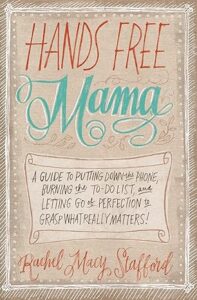
This post was originally published on another site, but I resharing it here as I think it is such a valuable conversation.
Note: There are some affiliate links below. This means that when you click, at no cost to you, The Family Trip receives a small benefit to support our website. You can read our disclaimer here.
I really wanted to love Hands Free Mama: A Guide to Putting Down the Phone, Burning the To-Do List, and Letting Go of Perfection to Grasp What Really Matters! by Rachel Macy Stafford. I rushed to order it when I discovered it. I couldn’t wait to devour it. The cover is calming, the reviews are great, and I believe in every part of the mission: unplug from devices and be with your kids more.
Like probably 95% of parents out there, this has been a personal challenge for years. It started with my New Year’s Resolution of 2014 to be “here.” Cell phones, social media, and the digital age can take over our lives, especially for those of us committed to blogging, marketing, and communications as a lifestyle and career.
Stafford has some moments of insight in this book that were medicinal. They were a bit painful to read but good to confront:
I probably would have continued to postpone living had it not been for this undeniable reality: there was always another project; there was no catching up; there was no slowing down. But all of that changed when I began to recognize the gift of today.
And moments of wonderful wisdom:
Protecting your time and talents from activities that leave you depleted is an essential step in establishing a sustainable Hands Free life.
But unfortunately, as much as I wanted to, I did not have a love affair with this book.
I turned the final page and had thoughts stewing immediately There are a lot of beautiful things Stafford asks us to consider and she opens our eyes to the possibility of a life more connected with our kids. She talks about finding peace, being a better person, being happier, and enjoying her children more. As a result, her kids and family end up enjoying her more, too. It is wonderful. Of course.
There is a flip side to this book though, that is not addressed. That is the over-commitment, the command to be perfectly unplugged, that starts to infiltrate this book. I couldn’t help but feel this was another form of mom guilt.
For the rose-colored lenses Stafford presents her experiment through are a little misleading.
For example, she tells a story of how she and her daughter were waiting in a doctor’s office for hours. Yet instead of bringing an electronic device to pass the time they lovingly colored, told stories, stroked each other’s hair, etc. It was a quiet, calm moment.
I love my children and we live an incredibly lean digital lifestyle. I can count on one hand the times I have presented electronic devices when we are out. But this scene irritated me.
Because let’s be honest about this: a digital-free lifestyle makes it HARDER to raise kids, much harder. So while many parents agree with Stafford’s presence, unplugging, it is far more complicated. And if a parent offers a movie on a long car ride, does that make them a “less than” parent?
I don’t use electronic devices in waiting rooms and my boys are bundles of untamed energy that will not just sit on my lap as we tell each other heartfelt stories. Instead, I constantly have to exercise my creativity to keep them from using the chairs in the waiting room as launchpads into space. I have to dig things out of my purse to keep them from wrestling each other. It isn’t sun-streaming-in enlightening moments of found connected peace. It is exhausting and tough. I do it because it is how I decided I want to parent, so my reasons are the same as Stafford’s, but it is misleading to tell parents that if they unplug they will automatically be gifted blissful moments like hers.
Sometimes, it sucks and is hard. But I do it because I know my parenting philosophy and am determined to stay true to it. It’s not easy. And just because there aren’t smartphones or devices around doesn’t mean that everything is calm and connected.
That is what got my back up a little about Stafford’s writing. The way the book is presented sets unrealistic expectations.
I love the initiative and challenge she is leading. Perhaps the flaw is that multiple blog articles do not synthesize necessarily synthesize into a well-rounded book.
I would also argue with Stafford on some other bigger points as well. The most critical is that it is OK to have time for yourself. Being hands-free should not translate to being all-sacrificing and there to entertain your kids all the time.
Witness a scene in the book where Stafford wants nothing more on Mother’s Day than to have time for herself. Instead though, somehow translating going digital-free into the requirement that all of her time be solely dedicated to her children, she goes where they want to go: to the pool.
…I was tempted to suggest that both girls go with their father. He would have happily obliged. I envisioned myself relaxing in bed, cracking open one of those delicious books on my bedside table, and then taking a long, indulgent nap. Now that sounded like a perfect Mother’s Day, if you ask me.
But my highly motivational yet sometimes inconveniently timed Hands Free inner voice had a very different opinion. It urged me to grasp what really mattered and go swimming with my family…
What then happens is a wonderful memory for the Stafford family of swimming and enjoying one another. I am happy for her.
Yet also irritated that taking time for oneself on Mother’s Day is not considered part of a healthy Hands Free life. Is there no in-between? Can’t I have Mother’s Day to relax and rest, then go get in the pool and splash the next day? Is this a zero-sum game where if the minutes are not spent engaged with children they are somehow lost minutes?
Most of my notes in the margins of this book read, “Moms, It’s okay to say NO, too!”
I also think there was a huge missed opportunity when it comes to how the Hands Free life affects the marriage. There is one excerpt in the book about this that I starred and dog-eared. It is something we don’t talk about enough in blogs, articles, and posts:
It wasn’t until I honestly assessed how often I reached for my phone in the presence of my spouse that my behavior changed…Engaging in regular, purposeful connection has made a significant impact on our relationship. We are closer than we’ve been in fifteen years of marriage.
But then after a few paragraphs, that’s pretty much it. There is so much to unpack here that could provide such value to relationships across the nation.
I agree with the tenets of Stafford’s teaching. Put the phone down. Step away from the devices. Be in the moment. Stop expecting the to-do list to matter most and, instead, jump in the pool. Her list on Page 222 of real things we can do to accomplish these goals is great.
But I think that the book could have benefited from a more rounded story, sharing all the fallacies of being human and accepting those flaws within a healthy, realistic Hands Free life.
I enjoy Staffor’s website to get short, daily inspirations to remember what matters, they are great posts. I wanted this book to be The Answer I was looking for. But for right now, I have to get off the computer to go snuggle my kids…as they use the sofa as a launchpad into space.

